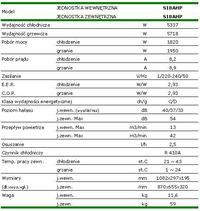Hello!
I am considering the possibility of installing air conditioning in my apartment and I have some doubts and I cannot find specific information on this subject. The only sensible place to install the indoor unit is about 4m away from the place where the outdoor unit could stand, but it is not the distance that bothers me. I mean, can the wires connecting both units be forced into the wall? I assume that yes, and now the question is whether the wires are probably insulated, can they be walled up in plaster or should they be placed, for example, in a plastic tray or some flexible pipe and only then walled up? This is important information for me because it will influence the decision to mount or not.
Why am I thinking about an additional cover for pipes, well, I read a few instructions and it says that during cooling, condensation may appear on the pipes and connectors. It might look bad if suddenly wet stains or even fungus appeared on the wall. The insulation used to insulate the cooling pipes is supposed to be airtight, but I cannot / do not want to allow myself to make a mistake when deciding how to do it.
I am asking for a quick and unambiguous answer - it is getting less and less pleasant so I would like to decide whether or not to install.
Regards.
I am considering the possibility of installing air conditioning in my apartment and I have some doubts and I cannot find specific information on this subject. The only sensible place to install the indoor unit is about 4m away from the place where the outdoor unit could stand, but it is not the distance that bothers me. I mean, can the wires connecting both units be forced into the wall? I assume that yes, and now the question is whether the wires are probably insulated, can they be walled up in plaster or should they be placed, for example, in a plastic tray or some flexible pipe and only then walled up? This is important information for me because it will influence the decision to mount or not.
Why am I thinking about an additional cover for pipes, well, I read a few instructions and it says that during cooling, condensation may appear on the pipes and connectors. It might look bad if suddenly wet stains or even fungus appeared on the wall. The insulation used to insulate the cooling pipes is supposed to be airtight, but I cannot / do not want to allow myself to make a mistake when deciding how to do it.
I am asking for a quick and unambiguous answer - it is getting less and less pleasant so I would like to decide whether or not to install.
Regards.



